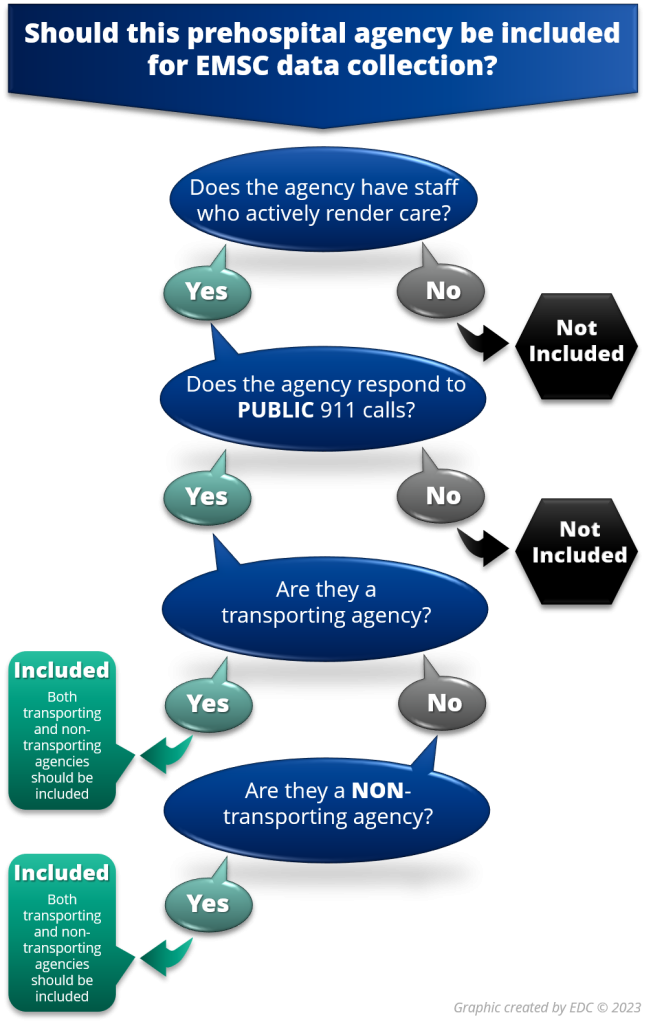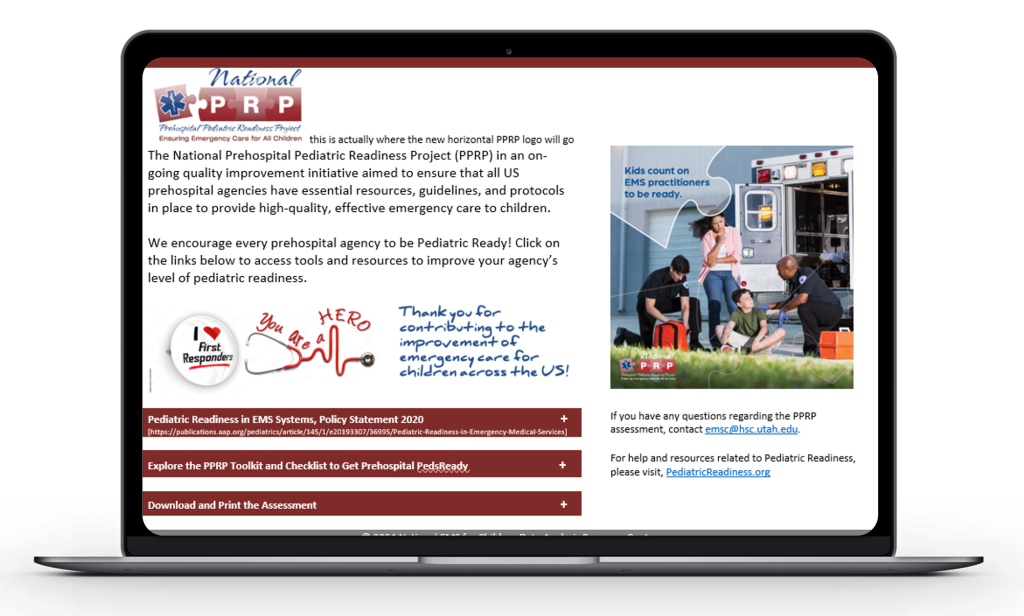National Prehospital Pediatric Readiness Project (PPRP) Assessment
This section is written as a resource specifically for EMSC Program Managers and Project Directors in mind – or whomever will be managing the data collection for the state/territory. To read more about the National Prehospital Pediatric Readiness Project, please visit the pediatric readiness website.
What is it?
The National Prehospital Pediatric Readiness Project (PPRP) Assessment is part of a national multi-phase quality improvement initiative to assess prehospital agencies’ readiness to treat pediatric patients based on 8 domains derived from the 2020 joint policy statement called Pediatric Readiness in Emergency Medical Services Systems and Technical Report:
- Education and Competencies for Providers
- Equipment and Supplies
- Interactions with Systems of Care
- Coordination of Pediatric Emergency Care
- Patient and Family-Centered Care in EMS
- Patient and Medication Safety
- Policies, Procedures, and Protocols
- Quality Improvement/Performance Improvement
Frequently Asked Questions
The rest of this page is organized to address the most frequently asked questions we receive from EMSC Program Managers and Project Directors about deploying this assessment and the data collection.
1. Which prehospital agencies should be surveyed for this data?
As part of this assessment, it collects data for performance measures 2.2, 2.3, and 2.4 and therefore uses the same prehospital agency definition. According to the definition in the 2023 EMSC Performance Measure Implementation Manual, a prehospital agency is defined as an organization staffed with personnel who actively render medical care in response to a public 911 or similar emergency call. This definition includes transporting and non-transporting agencies. The assessment is intended to be completed by the prehospital agency director (or equivalent) who has day-to-day knowledge of operations.
A list of these agencies for each state/territory with designated contact is in the EDC’s secure online Contact List Management System (CLMS). EMSC Program Managers have 24/7 access to the CLMS for updating, verifying, and managing their list of agencies as well as the contact information.
The list of prehospital agencies in CLMS is vital for the data collection because it populates the assessment website and some of the secure state/territory Tableau dashboards. Before each data collection begins, EDC staff will prepare a data quality report showing any data issues in your prehospital agency list like missing contact information which is needed for deployment. Links to the secure CLMS and Tableau systems for Program Managers can be found on our EDC & TA section under the Program Manager Secure Links & Resources at the bottom of the page.

2. Is there a minimum required response rate?
Similar to the EMS for Children Survey, the goal is an 80+% response rate. The higher the response rate a state/territory receives, the more confidence they have that the results are representative of the prehospital pediatric readiness in their state/territory.
The number of prehospital agencies per state/territory that meet the Program’s definition varies; therefore, so does the amount of effort for the data collection. For the EMS for Children Survey with prehospital agencies, we analyzed the MEDIAN number of prehospital agencies surveyed between 2020 and 2022 per state/territory. Check out those results on our website.
3. What is the data collection cycle and schedule for this assessment?

The first National Prehospital Pediatric Readiness Project (PPRP) Assessment is launched in May 2024. The EMSC Program plans to conduct this assessment every 5 years. According to this plan, the 2nd national deployment of the PPRP would be 2029.
The data collection life cycle for the 2024 PPRP assessment will be similar to the one followed by the National Pediatric Readiness Project (NPRP) Assessment with hospital emergency departments (EDs).
Before the PPRP assessment opens, it was preceded by Program Managers updating and verifying the prehospital agency contact information listed in CLMS. EDC staff assisted Managers with this part of the process by creating state/territory-specific data quality reports of this information which will show the data quality issues. Data quality issues can include missing contact information and/or information being in all capital letters or all lower-case letters. Promotion of the assessment will also be an important part of the prep work. Managers can find marketing materials for this assessment on our website under the Survey and Assessment Promotional Materials section.
Once the assessment opens, prehospital agencies have 3 months to complete the 30-ish minute assessment. Once an assessment has been completed for an agency, their name is greyed out and becomes inactive on the assessment website to decrease duplication of effort. For respondents, as soon as they submit their answers, a window automatically opens with a gap report which they can save. Managers can monitor respondent and non-respondent prehospital agencies in secure Tableau dashboards.
The assessment generally closes the last day of the month of the data collection. The weeks following the close, EDC staff export the 6,000+ responses. EDC staff then spend 1 to 2 months cleaning the data and preparing the final dataset for analysis. Cleaning and preparation include removing duplicates or incomplete responses as well as ensuring addresses are formatted in proper form for geographic analysis (urbanicity). Preliminary analysis is conducted while the data is geo-coded (latitude, longitude, census information, and urbanicity). The initial task of the EDC is to report national and state/territory performance measure results, hopefully within 2 months of the assessment close. Further and more in-depth analysis and programming for various secure Tableau dashboards for all responses and QI purposes starts approximately 3-5 months after the assessment has closed.
The months following the release of Tableau dashboards are used by Managers to share their results and educate prehospital agencies to effect improvement in the 8 domains listed above. Managers can find resources for these activities on our website under the Survey and Assessment Promotional Materials section.
4. Who sends the assessment invitation and reminders?

The PPRP and assessment is a collaboration of national organizations in which EMSC is a partner. The assessment is a national quality improvement effort requiring centralized national deployment for improved data quality, integrity, and comparability.
To ensure high-quality data, optimal response rates, and replicable data collection process for future assessments, standardized and strategic release of these communications are crucial. Standardized communications centered on an evidence-based survey strategic plan with consistent messaging and branding is critical to ensure that results of the assessment can be used nationally to showcase the impact of the EMSC State Partnership (SP) grant program. In addition, the terms related to the EMSC-SP program’s data collection requirements prior to application and award are stipulated in HRSA’s Notice of Funding Opportunity, HRSA-23-063, page 9.
Two options for the 2024 PPRP assessment were available for SP grant recipients:
- State-led Process in close collaboration with the EDC
- EDC-led Process in close collaboration with SP grant recipients.
State-led Process
Specific dates to release the PPRP approved-communications were provided by the EDC in the National PPRP Assessment Deployment Communications Strategic Plan – State-Led for those who selected this option and qualified according to ALL the criteria outlined below. The EDC guides SP grant recipients through this strategic plan which is centered on evidence-based survey methods. SP grant recipients selecting this option for the 2024 PPRP work closely with the EDC to ensure structured timelines and expectations will coincide with the National PPRP Assessment Deployment Communications Strategic Plan: State-led Process.
For EMSC State Partnership grant recipients who preferred to select the State-led Process, there are several HRSA-approved criteria, aligned with evidence-based survey methods, that are relatively easy to meet. The EMSC State Partnership grant recipient must:
- Have a dedicated and assigned EMSC Program Manager/Coordinator
- Have returned a DQR to the EDC by Sept 8, 2023
- Be able to email prehospital provider agencies directly in concert and alignment with the national assessment timeline in the strategic plan
- Commit to email the invitation and four reminders using the PPRP approved-template communications to each agency listed in CLMS
- Send personalized individual emails addressed to an individual at the CLMS agency or a job title where no name is available
- Call non-respondent agencies during the last ~6 weeks of the assessment using the PPRP approved calling script in collaboration and coordination with the EDC.
To initiate this process and to state your intention to oversee the PPRP assessment in your state, the on-line request form had to be completed by November 30, 2023.
EDC-led Process
Specific dates to release each of the PPRP approved-communications were provided by the EDC in the National PPRP Assessment Deployment Communications Strategic Plan – EDC-Led for those who selected this option. The EDC guides SP grant recipients through this strategic plan which is centered on evidence-based survey methods. SP grant recipients selecting this option for the 2024 PPRP assessment work closely with the EDC to ensure meeting structured timelines and expectations.
5. How many and when should I send assessment communications?

The number of 2024 PPRP assessment email letters (invite and reminders) to be sent is dependent upon which Process an EMSC State Partnership (SP) grant program is approved by HRSA.
Two options for the 2024 PPRP assessment were available for SP grant recipients:
- State-led Process in close collaboration with the EDC
- EDC-led Process in close collaboration with SP grant recipients.
The number and dates for each of 2024 PPRP assessment letters (invite and reminders) are outlined in the associated process strategic plan. EDC staff sent SP grant recipients the strategic plan based on which process they have been approved.
The number and frequency of these emailed letters are based on evidence-based survey deployment methods to ensure data quality, integrity, and comparability.
Contact your EDC TA liaison if you have any questions.
In the meanwhile, Managers can find the results of deployment analytics from the EMS for Children Survey on our website under the EMS for Children Survey section. Check out the those results on our website.
6. How or where can I customize the assessment for EMSC data collection?
The simple answer is that you cannot change any wording in the assessment for your EMSC data collection. The only exception is allowing states/territories to use their terms for the response options to the three assessment questions related to prehospital agency and provider levels. For the response options to these three questions, we are able to pipe in state/territory specific terminology which EDC staff will verify with each Program Manager before the assessment launches.
Please keep in mind this is a national quality improvement assessment supported by the federal EMSC Program. As such, it was subject to strenuous review and approval by the PPRP Steering Committee made up of over 40 subject matter experts. As part of their review and approval process, the PPRP Steering Committee pilot tested the survey questions with various prehospital agencies across the US and conducted one-on-one cognitive interviews with these participating prehospital agencies. The assessment development, review, and approval process took a little over 2 years.
While EDC staff create state/territory versions of the survey with their custom terms, you can download a general PDF version (English and Spanish) of the survey from our website.


